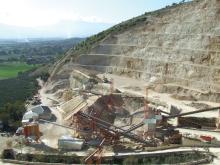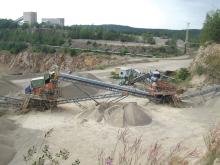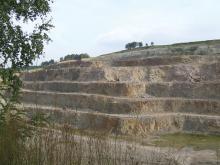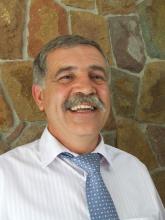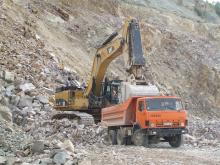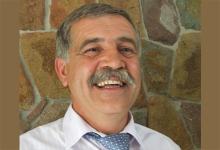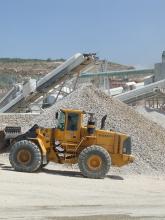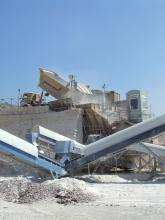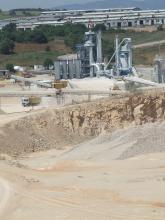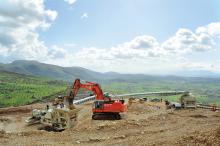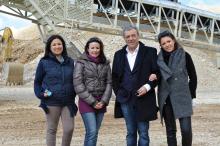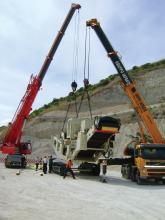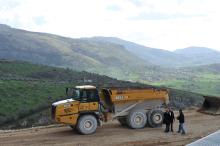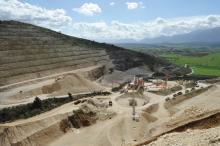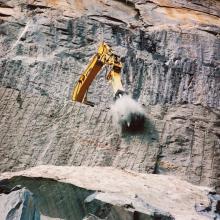
Issues with blasting forced Portugal’s Maceira Quarry to find a new primary extraction solution and now use one of the most powerful hydraulic breakers in the world. Claire Symes reports
Operating close to residential and commercial properties is becoming a reality for many European quarries, which poses significant issues for conventional drilling and blasting. Some are forced to limit production and blasting to specific hours but others are looking for alternative means of maintaining production.
Maceira Quarry in Portugal faced exactly this dilemma in 2002 when it became clear that a change of approach was needed in order to avoid closure of the site despite there being 60 years of reserves remaining.
To avoid the threat of closure, the quarry became one of the first in the country - and probably is still the only one - to solely use hydraulic breakers for primary extraction. While the quarry now produces 1.7million tonnes of material each year using breakers for extraction, the changeover was not a straightforward one.
The quarry, which supplies a co-located cement plant, is owned by
"The quarry extracts Jurassic limestone and marl for the cement works," explained Secil Maceira chief of production Nuno Marques. "There has been a quarry and cement plant at the site since the early 1920s and the location of the quarry was found by a Swiss geologist and exploits mid Jurassic to Cretaceous deposits."
MEETING DEMAND
Production at Maceira is split 60 to 70% from the limestone deposit and 30 to 40% from the marl depending on the demands from the cement works. The quarry produces 140,000 to 150,000tonnes of material each month - in better times it was closer to 170,000tonnes, according to Marques.
M A Sobral da Costa director Reuben Sobral Da Costa said, "This type of quarry would normally extract by drill and blast but there are too many houses and local businesses close to the quarry to allow this.
Using hydraulic breakers for primary breaking is unusual in Portugal - the Meceira quarry is believed to be the only one." Sobral Da Costa uses a fleet of
Sobral Da Costa said, "We started using the HB7000 breakers in 2003 when Maceira ceased to use drill and blast and used it effectively for four years. The trial started in the marl deposits with smaller breakers and we quickly moved into the limestone. It worked well but after seeing the HB10000 at Bauma, we wanted to try it here at Maceira.
"Atlas Copco arranged for us to trial a prototype of the new breaker and we managed to produce up to 700tonnes per hour with it. This was double the production that we were achieving with the HB7000 hammers. I think that for quarries producing between 1 and 2million tonnes of material each year, production with hammers is possible." Atlas Copco has a service contract with Sobral Da Costa which offers 100% availability and the company has a spare breaker on site, just in case one of the fleet fails.
CHANGES
The quarry dimensions had to be changed to suit the new production methods - the bench heights are shallower than would be used for conventional drill and blast. At Maceira the benches are now 5 to 6m, rather than the 8 to 12m that might be common for drill and blast applications. Haul road layouts were also changed to maximise efficiency.
"Using breakers makes for a safer operation - the lower bench height means that it is easier to reach the crest of the bench and continuously clean the face to avoid the potential of rock falls," said Sobral Da Costa. "The quarry floor is also smoother than we could achieve with drill and blast which helps to reduce wear and tear on the machines." Sobral Da Costa's experience with hydraulic breakers started with the company's involvement with the demolition market and breaking oversize material within the quarry. Nonetheless, the company could see the environmental problems with drill and blast at Maceira and wanted to change to using the hammers for primary breaking.
Hydraulic Breakers
1x Atlas Copco HB10000
3x Atlas Copco HB7000
1x Atlas Copco HB5600
Wheeled Loaders
2x Caterpillar 980
Excavators
1x Caterpillar 385
3x Caterpillar 375
1x Hitachi EX600
1x Liebherr 974
Rigid Dump Trucks
6x Terex 60tonne trucks
Crusher
O&K hammer crusher
"Back in 2002, Secil was very sceptical that it was not just financially viable but also efficient enough to meet the demand of the cement plant. They said it just could not compete with drill and blast," said Sobral Da Costa. "Atlas Copco worked closely with us to help us carry out some realistic trials and has been very supportive of this approach." Atlas Copco has an unusual arrangement with the company in that payment for equipment is linked to production. "If the customer earns, we earn," explained Atlas Copco sales manager Mario Dias who has worked closely with Sobral Da Costa since the start of the project. "But if they lose, so do we."
DAILY FOCUS
Sobral Da Costa uses three excavators to work the face continuously for a minimum of eight hours a day. "Breakers are more efficient as they can carry out three different tasks at one - they break, clean the face and smooth the quarry floor," said Sobral Da Costa.
"They also offer more even breaking too. Not all the cost of blasting is usually accounted for by many quarry operators - they only look at the costs of owning and operating the drill and the cost of the explosives. But in reality this doesn't take account of the need to carry out secondary breaking on oversize material and the potential of damage to the crusher from any oversize material that is missed. Since we have changed to using hydraulic breakers, we haven't had any problems with oversize material."
Use of the breakers has also enabled Sobral Da Costa to access more of the reserves. "In the marl pit, there were some deposits that we would just not have been able to remove with drill and blast due to the proximity of other buildings," said Sobral Da Costa. "But we have been able to extract these with the breakers."
After breaking the material is loaded into a fleet of
RESTORATION
Not many areas of the quarry have yet to be exhausted so restoration at Maceira is still at a very early stage. Nonetheless, work on restoring around 10% of the quarry started five or six years ago. The quarry used some of the waste sand material to place 1m thick layers on the benches and also to smooth out the benches in some areas, which were then planted with local tree species. Secil has more recently been working with an ecologist to advise on the right species to give a natural look the restored area.
Water management is also a key part of the daily work at the quarry and has to be pumped from sump ponds in both production areas but Marques said that the quarry has little problems with visual issues.
FUTURE DEMANDS
There are 50 years of reserves left in the quarry with the possibility to extend the quarry floor another 20m below its current level so finding an alternative method of extraction was essential for Secil. The quarry started to experience environmental problems 20 to 30 years ago and started to look for alternative extraction methods," said Marques.
Hydraulic breakers have now been used effectively at the quarry for over eight years, proving that high production can be delivered this way but the quarry still remains an oddity in Portugal. Nonethless, Dias said that he believes that in the future there will be more quarries working in this way. "The noise and vibration associated with drilling and blasting means that many quarries close to residential areas will either have to change or close," he said.
Living History
The Maceira quarry and cement plant almost feels part of the village with houses leading right up to the front gates but this is because many of the houses were built to house workers. Many are now privately owned but the plant remains a central part of the village and Secil makes strong efforts to ensure the plant is clean and cement dust does not affect the local area.
"We employ a company to continuously clean the site and there is a sense of pride among the workforce which helps to keep everywhere tidy," said Secil production manager Secil Maceira chief of production Nuno Marques. "There has been a quarry and cement plant at the site since 1923, which was started by ECL. The old cement plant and first building at the site have been preserved as a museum with artefacts from the old plant on display as well as ammonite fossils that have been found in the quarry."
In 1974 the plant was nationalised under Cimpor but was sold to Secil 15 years ago and since then Secil has invested continuously in the plant to achieve the highest safety and environmental standards. The annual production of the quarry is 1.7million tonnes and the plant produces 1.2million tonnes of cement each year. "The current plant comprises of lines five and six which are dry process plants which have capacity to produce 1400tonnes of clinker per day," said Marques.
The cement plant is powered by a number of alternative energy sources, including shredded tyres, waste wood products and shredded paper and plastics. Secil set a goal in 2010 for 35% of the power to come from alternative supplies.
The plant is the fourth largest in Portugal and serves the central and northern regions of Portugal. Cement is dispatched from the site by both rail and road. The site has its own rail connection that takes around 30% of the products.

